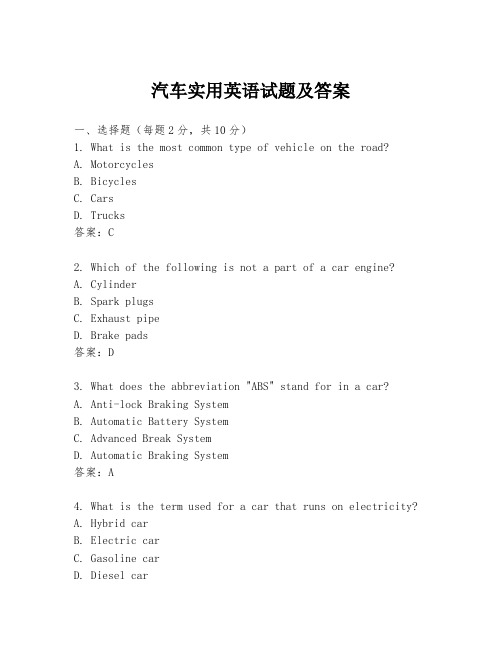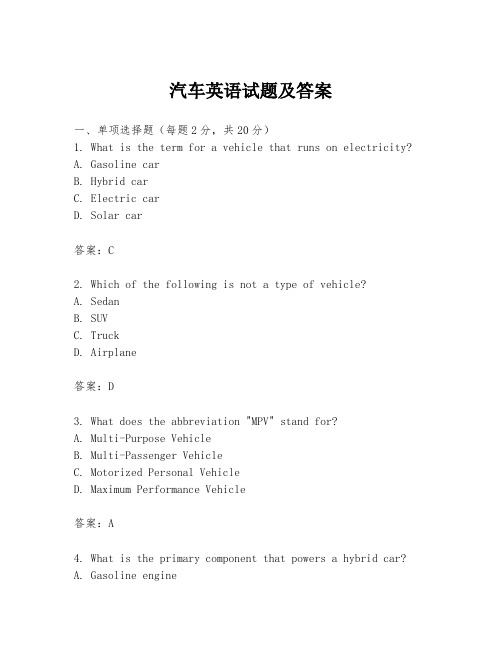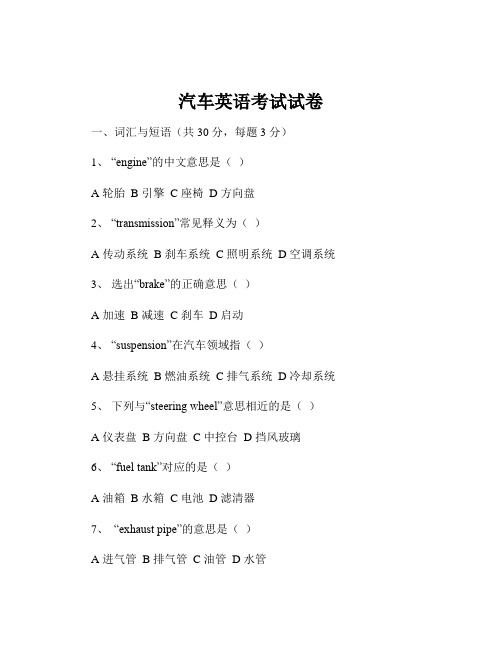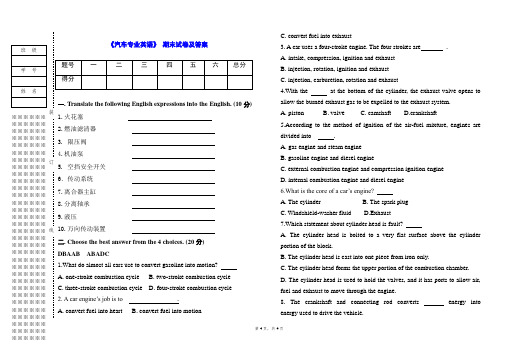汽车专业英语试卷(试题)
汽车实用英语试题及答案

汽车实用英语试题及答案一、选择题(每题2分,共10分)1. What is the most common type of vehicle on the road?A. MotorcyclesB. BicyclesC. CarsD. Trucks答案:C2. Which of the following is not a part of a car engine?A. CylinderB. Spark plugsC. Exhaust pipeD. Brake pads答案:D3. What does the abbreviation "ABS" stand for in a car?A. Anti-lock Braking SystemB. Automatic Battery SystemC. Advanced Break SystemD. Automatic Braking System答案:A4. What is the term used for a car that runs on electricity?A. Hybrid carB. Electric carC. Gasoline carD. Diesel car答案:B5. Which of the following is not a type of car insurance?A. CollisionB. ComprehensiveC. LiabilityD. Homeowners答案:D二、填空题(每题2分,共10分)1. The ________ is the part of the car that provides powerfor the wheels.答案:engine2. A ________ is a device that helps to reduce the speed of a vehicle.答案:brake3. The ________ is a safety feature that prevents the wheels from locking up during hard braking.答案:ABS4. An ________ car is one that uses a combination of an internal combustion engine and an electric motor.答案:hybrid5. ________ insurance covers the cost of repairing or replacing your vehicle if it's damaged or stolen.答案:Comprehensive三、阅读理解(每题2分,共20分)阅读以下短文,然后回答问题。
《汽车专业英语》期末试卷附答案第5套

二、Choose the best answer from the following questions (10×1’)1、The________ changes the up-and-down motion of the connecting rod into rotary motion.A. CrankshaftB. Piston pinC. Cap boltsD. Bearing2、In a car’s clutch , a flywheel connects to the engine , and a clutch plateconnects to the _____A. WheelsB. AxleC. DifferentialD. Transmission3、The transmissions have a to engage and disengage thetransmission.A. ClutchB. ITSC. DifferentialD. Cap bolts4、Which of the following does not aid in the powering of most mainstream carstoday ? ( )A. GasB. Solar energyC. AlternatorD. Battery5、Which material can’t be used to cast engine block ? ( )A. AluminumB. ChromiumC. Gray ironD. Sternum6、The of the engine is a measurement of the distance the pistontravels from TDC to BDC.A. CompressionB. DisplacementC. BoreD. Stroke7、When the piston is coming up on the compression stroke, spark will occurvery near .A. BDCB. ITSC. TDCD. BCM8、The diesel engine is more efficient, because it has compression ratio.A. HigherB. LowerC. RichD. Lean9、Which is not the way to reduce the pollutant in vehicle’s emission.A. EGRB. PCVC. Catalytic converterD. PCM10、What is the key part of the Vehicle?A. TransmissionB. EngineC. CylindersD. Condenser三、Translate the following Terms . (20×1’)(1) cylinder (2) chassis (3)crankshaft (4) clutch (5) throttle (6) sump(7) ECU (8) speedometer (9) differential (10) suspension (11) velocity (12) rim (13) steering (14) drum brake (15) diaphragm (16) vacuum (17) camshaft (18) stroke (19) airbag (20) valve四、Write the opposite meaning of the following Terms . (10×1.5’)1、increase2、advantage3、positive4、top5、upward6、mini7、TDC8、internal9、push 10、cold五、Write a short passage within 200 words to introduce thefuel cell-automobile. (1×25’)《汽车专业英语》答案一、1、piston pin 2、air fluid 3、compression power exhaust4、transfer case5、ABS6、757、rod cap, pressure cap, fuel cap8、〈9、positive crankcase veterinary10、alternator二、1-5、ADACD6-10、DCADB三、(1) 气缸(2) 底盘(3)曲轴(4) 离合器(5)节气门(6) 油盘(7)电子控制单元(8) 测速计(9) 差速器(10) 悬架(11) 速度(12) 轮缘(13) 转向(14) 制动器(15) 隔板(16) 真空(17) 凸轮轴(18) 行程(19) 安全气囊(20) 气门四、1、decrease 2、disadvantage 3、negative 4、bottom 5、downward6、max7、BDC8、external9、pull 10、warm五、论点正确5’叙述完整10’语句正确10’。
汽车英语试题及答案

汽车英语试题及答案一、单项选择题(每题2分,共20分)1. What is the term for a vehicle that runs on electricity?A. Gasoline carB. Hybrid carC. Electric carD. Solar car答案:C2. Which of the following is not a type of vehicle?A. SedanB. SUVC. TruckD. Airplane答案:D3. What does the abbreviation "MPV" stand for?A. Multi-Purpose VehicleB. Multi-Passenger VehicleC. Motorized Personal VehicleD. Maximum Performance Vehicle答案:A4. What is the primary component that powers a hybrid car?A. Gasoline engineB. Electric motorC. Both A and BD. Neither A nor B答案:C5. Which of the following is not a part of a car's engine?A. CylinderB. PistonC. Spark plugD. Windshield答案:D6. What is the function of a car's radiator?A. To cool the engineB. To clean the airC. To filter the fuelD. To power the engine答案:A7. What is the term for the distance a vehicle travels in a given amount of time?A. SpeedB. AccelerationC. DistanceD. Time答案:A8. What does ABS stand for in car technology?A. Anti-Lock Braking SystemB. Automatic Battery SystemC. Advanced Braking SystemD. Auxiliary Brake System答案:A9. Which of the following is a safety feature in modern cars?A. AirbagsB. CD playerC. Leather seatsD. Power steering答案:A10. What is the term for a car that is designed to be environmentally friendly?A. Eco-friendly carB. Luxury carC. Sports carD. Vintage car答案:A二、填空题(每题2分,共20分)1. The _______ is the part of the car that converts the engine's power into motion.答案:transmission2. A _______ is a type of car that is designed to be morefuel-efficient.答案:hybrid3. The _______ is the part of the car that helps to slow down or stop the vehicle.答案:brake system4. _______ is a system that helps to maintain a safe distance from the vehicle in front while driving.答案:Cruise control5. _______ is a type of car that is designed for off-road driving.答案:SUV6. The _______ is the part of the car that provides power to the wheels.答案:engine7. _______ is a type of car that is designed for high-performance driving.答案:sports car8. The _______ is the part of the car that helps to steer the vehicle.答案:steering wheel9. _______ is a type of car that is designed for carrying a large number of passengers.答案:minivan10. _______ is a type of car that is designed for luxury and comfort.答案:luxury car三、阅读理解题(每题3分,共30分)阅读以下短文,并回答问题。
汽车英语考试试卷

汽车英语考试试卷一、词汇与短语(共 30 分,每题 3 分)1、“engine”的中文意思是()A 轮胎B 引擎C 座椅D 方向盘2、“transmission”常见释义为()A 传动系统B 刹车系统C 照明系统D 空调系统3、选出“brake”的正确意思()A 加速B 减速C 刹车D 启动4、“suspension”在汽车领域指()A 悬挂系统B 燃油系统C 排气系统D 冷却系统5、下列与“steering wheel”意思相近的是()A 仪表盘B 方向盘C 中控台D 挡风玻璃6、“fuel tank”对应的是()A 油箱B 水箱C 电池D 滤清器7、“exhaust pipe”的意思是()A 进气管B 排气管C 油管D 水管8、“dashboard”通常指的是()A 后备箱B 发动机舱C 仪表盘D 底盘9、“clutch”在汽车中是()A 离合器B 变速器C 差速器D 传动轴10、“radiator”的释义为()A 散热器B 起动机C 发电机D 电动机二、句子翻译(共 30 分,每题 6 分)1、 The car's brakes need to be repaired2、 The engine is running smoothly3、 The suspension system of this car is very advanced4、 Please check the fuel level in the tank5、 The steering wheel is not responding properly三、阅读理解(共 40 分)Passage 1Cars have become an essential part of modern life They provide us with convenient transportation and give us the freedom to travel wherever we want However, owning a car also comes with responsibilities Regular maintenance is crucial to ensure the safety and performance of the vehicleOne of the most important aspects of car maintenance is checking the engine oil The engine oil lubricates the moving parts of the engine and helps to reduce friction and wear It is recommended to change the engine oil every 5,000 to 10,000 miles, depending on the type of car and driving conditionsAnother important component to check is the brakes Brakes are essential for safe driving, and any problems with the brakes should be addressed immediately Regularly inspect the brake pads and discs for wear and replace them if necessaryTires are also an important part of a car's safety and performance Check the tire pressure regularly to ensure proper traction and fuel efficiency Rotate the tires every 5,000 to 7,000 miles to ensure even wearIn addition to these mechanical components, it is also important to keep the car clean both inside and out A clean car not only looks better but also helps to prevent rust and damage to the paintQuestions:1、 Why is regular car maintenance important? (8 分)2、 How often should the engine oil be changed? (8 分)3、 What should be done if there are problems with the brakes? (8 分)4、 Why is it important to check the tire pressure regularly? (8 分)5、 What is the benefit of keeping the car clean? (8 分)Passage 2The automotive industry is constantly evolving New technologies are being developed to make cars more efficient, safer, and environmentally friendly Electric cars are becoming increasingly popular as people become more concerned about the environment and the high cost of gasolineHybrid cars, which combine a gasoline engine with an electric motor, are also a viable option for those who want to reduce their fuel consumption without fully committing to an electric vehicle Selfdriving cars are another area of innovation that has the potential to revolutionize the way we travelHowever, these technological advancements also present challenges The infrastructure for charging electric cars needs to be expanded to make them more convenient for longdistance travel Safety regulations for selfdriving cars need to be established to ensure the safety of passengers and other road usersThe automotive industry also faces competition from alternative forms of transportation such as ridesharing and public transportation To stay competitive, car manufacturers need to continue to innovate and improve the quality and features of their vehiclesQuestions:1、 Why are electric cars becoming more popular? (8 分)2、 What is a hybrid car? (8 分)3、 What potential does selfdriving cars have? (8 分)4、 What challenges do the technological advancements in the automotive industry present? (8 分)5、 How can car manufacturers stay competitive? (8 分)。
《汽车专业英语》 期末试卷及答案

C. convert fuel into exhaust3. A car uses a four-stroke engine. The four strokes are .A. intake, compression, ignition and exhaustB. injection, rotation, ignition and exhaustC. injection, carburetion, rotation and exhaust4.With the at the bottom of the cylinder, the exhaust valve opens to allow the burned exhaust gas to be expelled to the exhaust system.A. pistonB. valveC. camshaftD.crankshaft5.According to the method of ignition of the air-fuel mixture, engines are divided into .A. gas engine and steam engineB. gasoline engine and diesel engineC. external combustion engine and compression ignition engineD. internal combustion engine and diesel engine6.What is the core of a car’s engine?A. The cylinderB. The spark plugC. Windshield-washer fluidD.Exhaust7.Which statement about cylinder head is fault?A. The cylinder head is bolted to a very flat surface above the cylinder portion of the block.B. The cylinder head is cast into one piece from iron only.C. The cylinder head forms the upper portion of the combustion chamber.D. The cylinder head is used to hold the valves, and it has ports to allow air, fuel and exhaust to move through the engine.8. The crankshaft and connecting rod converts energy intoenergy used to drive the vehicle.B. mechanical, thermalD. mechanical, kinetic9. What causes a car to burn and lose oil?B. Radiator troubleC. A failing exhaust systemScreened intake B. oil filter C. oil pump D.oil pressure. Reading Comprehension (20分)Task 1After reading the following passage, make the correctA computer is a machine designed to perform work mathematically andor electronic means. These machines can do a great deal of Its percentage of error is about one in a billion digits. It has been The heart of an electronic computer lies in its vacuum tubes, or to solve can be solved by a computer in one minute, but in order to work properly, a computer must be given instructions and it must be programmed. Computers can be designed for many specialized purposes. They can be used to prepare patrols, guide airplane flights, direct traffic, even to play chess. Computers play an important role in automation process in plants and factories throughout the world.1.A computer is a machine designed to ______________________.A.perform work mathematicallyB.perform complicated calculationsC.store and select informationD.all of the above2.The speed with which an electronic computer works depends on its________________A.electronic circuitsB.programmerC.vacuum tubes or transistorsD.instructions3.According to the passage, computer play an important role in__________________A.automation processesB.mathematical computationsC.traffic controlD.the development of mathematical theory4.The use of computers for specialized purpose depends on the___________________A.design of the computerpower used to operate the computerdifficulty of the mathematical calculations involvedthe ability of the programmerThe passage implied that human beings differ from computers in that human beings ______________make fewer mistakesdo not have to be programmedwork more quicklyunderstand their instructionsTask 2Directions:After reading the passage, complete the statements.When Abraham Lincoln was young he worked in a store. As a clerk he articles(杂货). They added up to two dollars and six cents, or the小事),and many clerks would dismissed it as such. But Abraham was too conscientious(认真的) to“The money must be paid back,” he decided. This would have been easy had the woman lived just round the corner, but, as the young man she lived between two and three miles away. This, however, did not to the residence of his customer. Having arrived there, he explained the matter, paid over the six cents, and returned satisfied.6. What did Abraham do when he was young?He worked as a clerk in_________________________.7. What did the woman buy?The woman bought ____________________________.8. How did he feel after he found that he had made the woman pay six cents too much?He felt ___________________________________________.9. The woman lived between____________________ miles away.10. What did Abraham do after he arrived at the residence of the woman?He explained the matter, __________________the six cents, and returned satisfied.四. Translate the following sentences into English (20分)1.今天的普通汽车由超过15000个独立的、单个的的零部件组成,这些零部件必须一起工作。
汽车英语考试试题题库

汽车专业英语试题(含答案)一、单词互译(英译汉)1、 Automobile2、 Classification3、 Combustion4、 Chamber5、 Circulate6、 Crankshaft7、 Antifreeze8、 Carburetor9、 Mechanics10、Air–fuel mixture(汉译英)1、连杆n.2 、点燃 n.3 、简洁地 adv.4 、(使)旋转 v.5 、发动机n.6 、要求v.7 、输送v.8 、活塞n.9 、系统n.10、气缸n.二、词汇和语法1、The ______ of piston movement is called TDC (top dead center).A、upper limitB、lower limitC、limit2、A _____ is piston movement from TDC to BDC or from BDC to TDC.A、strokeB、stageC、state3、The actions ______ can be divided into four stages, or strokes.A、taken place in the engine cylinderB、taking place in the engine cylinderC、take place in the engine cylinder4、 This advantage prevents the diesel engine replacing thegasoline engine in some automobiles and airplanes.A. toB. forC. from5、 In any internal combustion engine burning fuel heats air consequently.A. whichB. thatC. when6、In the case of the diesel engine the supply is effected by anA. injectB. internationalC. injection7、The fundamental difference gasoline and diesel engines isin the gasoline engine the source of the heat for igniting the charge.A. both, thatB. between, thatC. between, which8、Both kinds of engines internal combustion engines, eachof them has its characteristic features.A. is, butB. are, butC. are, and9、Let us compare the diesel engine the gasoline engine.A. onB. aboutC. with10、The mixture of the gasoline engine is provided by a carburetor.A. explosiveB. expensiveC. expands三、阅读与理解Part 1The engine is the source of power that makes the wheels go around and the car move. The automobile engine is an internal combustion engine because the fuel (gasoline) is burned inside it.The burning of gasoline inside the engine produces high pressure in the engine combustion chamber .This high pressure forces piston to move, the movement is carried by connecting rods to the engine crankshaft. The crankshaft is thus made to rotate: the rotary motion is carried through the power train to the car wheels so that they rotate and the car moves.1.What do we see from the first paragraphs? ( )A.The engine is source of power for a car.B.The engine can not make wheels go around.C.The engine is resource of oil.2.Which one Statement is true according the above first paragraph?( )A.The automobile engine is an international combustion engine.B.The automobile engine is an external combustion engine.C.The automobile engine is an inner combustion engine3.What do we see from the second paragraphs? ( )A.High pressure is source of power inside a engine.B.Crankshaft is rotated without any force.bustion chamber is not a part of the engine.4.Which one Statement is true according the above second paragraph?( )A.The movement of piston is carried by connecting rods to the enginecrankshaft.B..This lower pressure forces piston to move.C.Both of A and B are true.5.Which one Statement is true according the last sentence in the article?( )A.The power train is required for a car moving.B.The rotary motion of crankshaft is enough for a car moving.C.Both A and B are false.Part 2The engine also needs a cooling system; the combustion of theair-fuel .The mixture in the engine creates a very high temperature (as high as 2000℃ to 2700℃). The cooling system takes heat away from the engine by circulating a liquid coolant (water mix with antifreeze) between the engine and a radiator .The coolant gets hot as it goes through the radiator. Thus, the coolant continually takes heat away from theengine, where it could do damage, and delivers it to the radiator .Air passing through the radiator takes heat away from the radiator.6.What do we see from above paragraph? ( )A.a cooling system is must for the engine .B.The engine don’t need a cooling systemC.The engine might need a cooling system.7. How much will be created the temperature of the mixture in the engine? ( )A. As high as 2000℃ to 2700℃.B. As high as 1300℃ to 2000℃.C. Not higher than 2000℃.8. What is liquid coolant? ( )A. water mix with antifreezeB. water used by the cooling system.C. Any liquid used by the cooling system.9. What do we see from above paragraph? ( )A. The coolant gets HOT as it goes through the radiatorB. The coolant gets COOL as it goes through the radiatorC. Both A and B are false.10. Which one Statement is true in the article? ( )A. Air passing through the radiator takes heat away from the radiator.B. Air passing through the radiator gets MORE heat.C. Both A and B are false.四、翻译A 英译汉。
《汽车专业英语》期末试卷附答案第1套

performance directly affects the car's power, economy, reliability, safety, comfort and emissions.3、In addition, the car body is the shell of the whole car, which can reflect the characteristics of the car's appearance image most intuitively, which determines that the modern car body design pays great attention to the external shape to meet the aesthetic requirements of the car shape, and better develop a car market.4、A double overhead cam engine has two cams per head. So in-line engines have two cams, and V-type engines have four.5、所以冷却系统的另一个重要作用是让发动机尽快的升温,并保持在稳定的温度范围内。
.三、Answer the following questions in English. (3×5’)1、Why do we need the cooling system in an IEC(内燃机)?2、What is the function of the braking system?3、What’s the displacement of an engine?四、Choose the right answer. (10×2’)1. What do almost all cars use to convert gasoline into motion?A. one-stroke combustion cycleB. two-stroke combustion cycleC. three-stroke combustion cycleD. four-stroke combustion cycle2. A car engine’s job is to .A. convert fuel into heartB. convert fuel into motionC. convert fuel into exhaust3. A car uses a four-stroke engine. The four strokes are .A. intake, compression, ignition and exhaustB. injection, rotation, ignition and exhaustC. injection, carburetion, rotation and exhaust4. With the at the bottom of the cylinder, the exhaust valve opens to allow theburned exhaust gas to be expelled to the exhaust system.A. pistonB. valveC. camshaftD.crankshaft5. According to the method of ignition of the air-fuel mixture, engines are divided into .A. gas engine and steam engineB. gasoline engine and diesel engineC. external combustion engine and compression ignition engineD. internal combustion engine and diesel engine6. What is the core of a car’s engine?A. The cylinderB. The spark plugC. Windshield-washer fluidD.Exhaust7. Which statement about cylinder head is fault?A. The cylinder head is bolted to a very flat surface above the cylinder portion of the block.B. The cylinder head is cast into one piece from iron only.C. The cylinder head forms the upper portion of the combustion chamber.D. The cylinder head is used to hold the valves, and it has ports to allow air, fuel and exhaust to move through the engine.8. The crankshaft and connecting rod converts energy into energy used to drive the vehicle.A. thermal, mechanicalB. mechanical, thermalC. kinetic, mechanicalD. mechanical, kinetic9. What causes a car to burn and lose oil?A. Lack of gasB. Radiator troubleC. A failing exhaust systemD. An old engine with piston rings that no longer seal the cylinder and piston properly.10. What is the heart of the lubrication system, which is located in the oil pan on thebottom of the engine? And it pulls oil up from the oil pan and makes the engine oil circulate through the engine.A. Screened intakeB. oil filterC. oil pumpD.oil pressure relief valve五、Write a short passage to describe(描述)the principle ofthe gasoline direct injection system within 300 words . (1×25’)《汽车专业英语》答案一、1、汽车2、性能,容量3、碰撞,冲突4、扭矩5、节温器6、风扇7、方向盘8、双凸轮轴顶置9、cylinder 10、PCV二、1、制动系使行驶中的汽车减速甚至停车,使下坡行驶的汽车的速度保持稳定,以及使已停驶的汽车保持不动,这些作用统称为汽车制动。
【精品】汽车专业英语试卷(试题)

汽车专业英语试卷(试题)------------------------------------------作者------------------------------------------日期.......最新精品资料合集.......一、1.Power Train: 动力传动系, 动力传动机构2.Suspension:悬挂3.Cylinder: 气缸4.Transmission: 变速器5.Gasoline: 汽油6.Final Drive: 主减速器7.Leaf Spring: 钢板弹簧8.Piston: 活塞9.TDC: 上死点(Top Dead Center);10.Lubrication: 润滑11.Muffler: 消音器12.Planetary Gear: 行星齿轮13.Disc Brake: 盘式制动器14.Venting System: 透气系统15.Hybrid: 混合(动力)二、1.Today’s average car contains more than 15000 separate, individual parts that must work together. These parts can be grouped into four major categories: body,engine,chassis and electrical system.今天的普通汽车由超过15000个独立的、单个的的零部件组成,这些零部件必须一起工作。
这些部件可以分为四大类:身体、发动机、底盘和电气系统。
2. Gasoline and Diesel are called heat engines, the burning fuel generates heat which causes the gas inside the cylinder to increase its pressure and supply power to rotate a shaft connected to the power train.汽油和柴油叫做热力发动机,燃烧燃料产生热使得缸内压力增加并且提供动力驱动动力系统传动轴.3. An automatic transmission performs similar functions to a manual transmission except that gear selection is controlled either htdraulically or electronically. 自动变速执行的功能和手动变速器相似,只是选档选择由液压或者电气控制。
- 1、下载文档前请自行甄别文档内容的完整性,平台不提供额外的编辑、内容补充、找答案等附加服务。
- 2、"仅部分预览"的文档,不可在线预览部分如存在完整性等问题,可反馈申请退款(可完整预览的文档不适用该条件!)。
- 3、如文档侵犯您的权益,请联系客服反馈,我们会尽快为您处理(人工客服工作时间:9:00-18:30)。
一、1.Power Train: 动力传动系, 动力传动机构
2.Suspension:悬挂
3.Cylinder: 气缸
4.Transmission: 变速器
5.Gasoline: 汽油
6.Final Drive: 主减速器
7.Leaf Spring: 钢板弹簧
8.Piston: 活塞
9.TDC: 上死点(Top Dead Center);
10.Lubrication: 润滑
11.Muffler: 消音器
12.Planetary Gear: 行星齿轮
13.Disc Brake: 盘式制动器
14.V enting System: 透气系统
15.Hybrid: 混合(动力)
二、1.Today’s average car contains more than 15000 separate, individual parts that must work together. These parts can be grouped into four major categories: body,engine,chassis and electrical system.
今天的普通汽车由超过15000个独立的、单个的的零部件组成,这些零部件必须一起工作。
这些部件可以分为四大类:身体、发动机、底盘和电气系统。
2. Gasoline and Diesel are called heat engines, the burning fuel generates heat which causes the gas inside the cylinder to incr ease its pressure and supply power to rotate a shaft connected to the power train.汽油和柴油叫做热力发动机,燃烧燃料产生热使得缸内压力增加并且提供动力驱动动力系统传动轴.
3. An automatic transmission performs similar functions to a manual transmission except that gear selection is controlled either htdraulically or electronically. 自动变速执行的功能和手动变速器相似,只是选档选择由液压或者电气控制。
4. The purpose of the complete suspension system is to isolate the vehicle body from road shocks and vibrations, which will otherwise be transferred to the passengers and load.(完整的)悬挂系统的用途是隔离路面对车身的路冲击和振动,否则路冲击和振动将传递给乘员和载荷。
5. All vehicles must fitted with at least 2 independent brake systems. They were once called the service brake and the emergency brake.所有的车辆必须配备至少2个独立的制动系统。
它们被称为行车制动器和停车制动器(紧急制动器)。
6. The pressure developed within the combustion chamber is applied to the head of a piston to produce a usable mechanical force.燃烧室的压力推动活塞头部产生可用的机械力。
7. The valve system is made up of those parts needed to open and close the valves at just the right time.气门系统由一些可以控制气门在正确的时间气门打开和关闭的零部件组成。
8. The burned gases removed from the combustion chamber contain such harmful emissions as hydrocarbons,carbon monoxide and nitrous oxides.燃烧室已燃烧的气体包含有害的排放物如碳氢化合物,一氧化碳和氮氧化物。
9. The location of the driving axle determines whether the vehicle is classified as rear-wheel drive,front-wheel drive,four-wheel drive or all-wheel drive.传动轴的位置决定车辆的分类是后轮驱动,前轮驱动,四轮驱动或者全轮驱动。
10、In commercial vehicles, the necessary final-drive ration can only rarely be accommodated in one stage. For this reason, use is usually made of more elaborate final-drive systems.在商用车,主减速器只能极少被装配在一个阶段。
出于这个原因,通常是使用更复杂的主减速器。
11. There are two main ways of building automobiles. They are built using body/frame construction and unitized body construction.有两种主要的方式构建汽车。
它们建立使用身体/框架结构(非承载式车身)和整体车身结构(承载式车身结构)。
三、1.A chassis which is considered as a support frame for an auto body is used to
assemble all auto spare on it. In fact, when power from engine continues to be transmitted to chassis, it begins with power t rain, goes on to steering, wheel suspension, brakes and tires. These individual components interact with each other closely. Therefore, a chassis itself can be divided into the following systems.
汽车底盘也被视为一个支架(机架),将所有的汽车零部件在其上组装。
事实上,当动力从发动机继续传送到底盘,它开始于传动系,接着是转向系统,轮悬挂、刹车和轮胎。
这些单独的组件相互密切作用。
因此,底盘本身可以分为以下系统。
2.The engine block serves as a rigid metal foundation for all parts of an engine. It contains the cylinders and supports the crankshaft and camshaft. In older engines, the valve seats, ports, and guides are built into the block. Accessory units and the clutch housing are bolted to it. Blocks are made of either cast iron or aluminum. The lighter the block (providing it has sufficient strength), the better.
发动机缸体是汽车发动机所有部件的一个钢性金属基础。
它包含气缸并且支持曲轴和凸轮轴。
在老式发动机,气门座,汽门,气门导管都在发动机缸体内.附件单元和离合器壳也用螺栓固定在发动机缸体上.发动机缸体是铸铁或者铝.发动机缸体重量(有足够的强度)越轻越好.
3.现代离合器是单盘式、干式盘(或叫干式离合器)。
它包括五个主要部分:
飞轮、离合器盘、压盘总成,离合器分离轴承,离合器分离机构。
其他组成离合器总成的其他部件是传动输入轴和离合器壳。
- 1 -。
